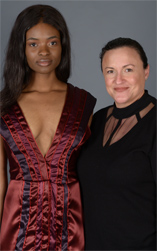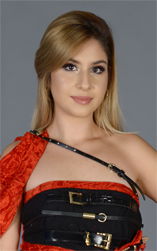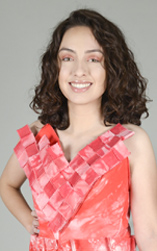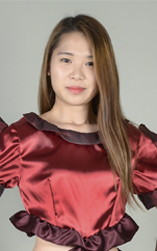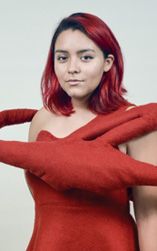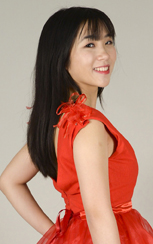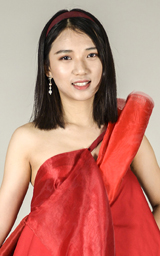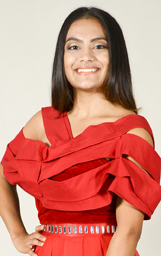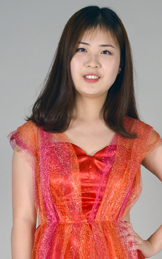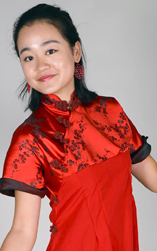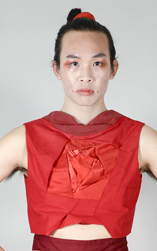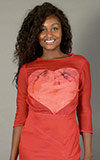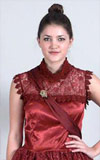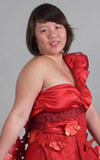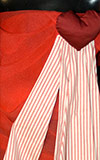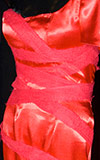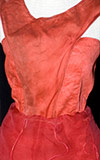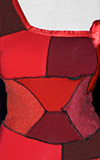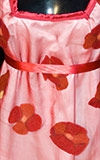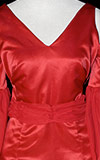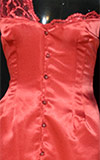Women's Cardiovascular Medicine Program
Red Dress Collection

As part of a unique partnership between the UC Davis Women’s Cardiovascular Medicine Program and the UC Davis Department of Design, fashion design students create a collection of red dresses to raise awareness that heart disease is the leading cause of death among women. Each year in February, new designs are unveiled at the UC Davis Women’s Heart Care Education and Awareness Forum, which is held in Sacramento during National Heart Month.
Each dress represents the student's individual design aesthetics and personalities, while raising awareness that heart disease is the leading killer of women and encouraging heart-healthy lifestyles.
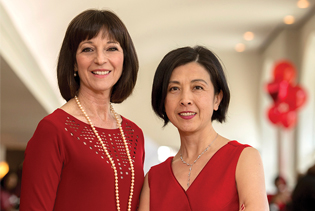
UC Davis cardiologist Amparo Villablanca launched the student red dress collection and the nation’s first program dedicated to women’s heart health. In her clinic and outreach, Villablanca educates women about the importance of thinking about their hearts — even in their 20s and 30s, because heart disease develops over the course of decades.
The dress designers are mentored by Adele Zhang, who teaches fashion and textile design in the UC Davis Department of Design and is the curator for the UC Davis Design Collection and Design Museum. With her multicultural background, industry and business experience, Zhang links wearable design with real-world applications.
Our partners in women's heart health
- American Heart Association Go Red For Women Campaign
- Women Heart National Coalition for Women with Heart Disease
Red Celestial – designed by Tenzin Youedon and modeled by Ayiana Melia Keith
 Red Celestial – designed by Tenzin Youedon and modeled by Ayiana Melia Keith
© UC Regents
|
Designer’s statement: My “Red Celestial” dress symbolizes a spiritual garment to protect women from heart disease. This dress contains fun and special elements, from the red coral that falls down the chest to the red patches on the stomach. I want this dress to make women feel powerful and protected as if wearing it will serve them a layer of strength that can only be found from forces the eye cannot see. Red coral serves as a warning symbol for the wearer; if the red fades, it signals to the wearer that there might be health problems in the future. The long tight sleeves are a common element of Tibetan culture, predominantly inspired by Buddhism. The bark-like pleats on the stomach represent the strength of trees and add an exciting texture to the garment. Every resource used for this project is second-hand and adds a |
Keep Beating – designed and modeled by Katherine Guevara
|
Designer’s statement: My red dress is inspired by the lifeline at hospitals that patients are connected to. The lifeline symbolizes the way a patient’s heart is beating. If it is beating fast, for example, the lifeline will move faster. My dress is aimed to bring attention to women’s heart disease in order for them to take the necessary precautions and keep their hearts beating for many years to come. The lifeline motif is incorporated on the outside top and the cape/train through the manipulation of patterns on the sequin fabric. I want my dress to empower women, so they don’t have to be afraid of heart disease and decide to take control of their health. For this reason, I chose to make pants. A dress is expected, but it is also expected that women may falsely believe that heart disease is not their leading cause of death. My aim was to defy expectations by not designing a typical dress. My hope is that it inspires women to defy expectations by taking charge of their heart health. |
Pump – designed by Catherine Llarena and modeled by Adetomiwa Ilori
|
Designer’s statement: My inspiration was to create a red dress that emulates the strength of the heart. Not only does it pump blood through the circulatory system, it carries oxygen and nutrients throughout the body while returning deoxygenated blood back to the heart. It is also through the heart where we feel our emotions. When designing the dress, I wanted to create the physical parts and the emotional parts of the heart. I added piping that's sewn from the shoulders to the length of dress like the arteries and veins in the human body. The different tones of red are like blood. When it is oxygenated, the blood is bright red. I used darker shades of red such as maroon and purple to symbolize when blood is deoxygenated. Emotionally, I wanted this dress to have a rhythm and a natural flow that would articulate the heart in the female body that is exuberant of strength and beauty. |
No. 1 – designed and modeled by Pamela Munoz
|
Designer’s statement: I wanted to create a dress that would empower women to “fight the fight” against heart disease. Even though I have not had anyone around me be diagnosed, I can only imagine how impactful and fearful one may feel if diagnosed with such life-threatening condition. Having that in my mind and heart, I wanted this dress to look and make women feel ready to fight fearlessly, empowered, confident, strong and beautiful. In order to create the dress I had in mind, I took inspiration from Greek goddesses, because we relate to them as very strong, powerful, superior warrior women. In addition, I kept thinking back to a symbol I would always see on the roads of my childhood in Costa Rica. The symbol consists of a heart with a belt on it. The message behind this symbol was to take care of your life on the road by wearing a seat belt. Taking that idea, I added belts to my dress to give the same message. In this case, to bring awareness and motivate women to check on their hearts on a regular basis, because every life is valuable. Finally, I decided to name this piece “No.1,” because in a battle there is always a side that comes out victorious and a side that gets defeated. In this case, my Greek goddess serves as a reminder to be ready to fight and come out as number 1. |
Fenix – designed by Raiden Sherk and modeled by Marcy Patra
|
Designer’s statement: With my red dress, I was inspired by the mythological image of the Phoenix and its symbolism of rebirth, strength and renewal. I wanted to translate the majesty and power of the Phoenix into my dress and subsequently to its wearer. The raw and unfinished edges in parts of the dress attempt to capture some of the raw strength of the Phoenix. Heart disease takes courage and strength to battle, and the women who do so embody strength in their own right, sharing a connection with the Phoenix. |
Bloodflow — designed and modeled by Johany Huinac De Leon
|
Designer’s statement: I took inspiration from many things for my red dress: the inner workings of the human body, the geometrical contrasts of a sliced pomegranate and the jagged, uneven pieces of the ceramic piece called “Expansion Through Creative Destruction.” The last two inspired me to create a piece with sharp, asymmetrical lines for the structure with a fabric design that juxtaposes those sharp lines with a rounder texture. Since this is a red dress, I looked to the human body and heart as inspiration for the colors and overall shape. We are all (mostly) composed of the same body parts and organs, but you will not find our veins following the same pattern. I wanted to demonstrate the uniqueness of each person’s heart and blood, or how I imagine them to be, in the fabric design. The dying technique used in the fabric makes a random, matchless pattern, just like the direction of the veins and arteries in our bodies. |
Brave Heart — designed and modeled by Agnes Lam
|
Designer’s statement: My red dress design is inspired by Rosa chinensis, which is a flower called the China rose. Symbolically, this flower represents pure love, passion, chastity and courage. My design focuses on courage. Although cardiovascular diseases are frightening, they are often preventable. My dress shows we should be bold and bravely face our fears. It encourages people to properly care for their hearts and fight this leading cause of death in women. It also spreads awareness to encourage support for programs dedicated to protecting women against cardiovascular disease. This gift of life was thoughtful, cherished and one-of-a-kind, so women treat their hearts with as much care as they would with any other beloved gift. Design elements include the bodice front, which forms a heart shape in the middle, drawing attention to the heart and highlighting its importance for survival. I used gathering fabric to create the shape of the China rose around the dress, which highlights the beauty of the wearer and shows off the unique and beautiful heart given to her at her birth. |
Felt Heart — designed and modeled by Adela Palominos
|
Designer’s statement: I made this dress because it’s what popped into my head when I thought of a healthy human heart. I wanted the dress to look sturdy but soft and structured but huggable, because a healthy heart needs to be sturdy and structured in order to do its job well for the entirety of our lives. But the heart also represents emotion; something that loves and is comforting. The wool allowed me to build a dress that was seamless and nearly perfect. |
Floral Me Gentle — designed and modeled by Alyssa Vang
|
Designer’s statement: The inspiration for this red dress is a Hmong jewelry called “xauv” (sa-ow). Xauv is always worn with cultural attire to represent as a “lock” to protect one’s soul and health. This is one of the most important pieces in the Hmong culture, and I thought it would make a perfect fit for women’s heart health because I believe it can represent a charm to keep others healthy. It’s important to me as a woman and for my own Hmong community to stay healthy. I think it’s meaningful when another person with the same culture or similar culture recognizes something they see that is a part of their life and can relate it to another topic. I feel like it also brings attention to the audience when a dress is not a normal everyday dress they see, a touch of cultural aspect adds interest. Another inspiration for the dress from is the hibiscus flower. I find the shape of this flower beautiful, and there are a lot of health benefits from hibiscus tea. My dress is unique because it combines who I am, both Hmong and American cultures. This dress is meaningful to me because I can reach out to the world about my culture and spread the word about women’s heart health. |
In Control — designed and modeled by Alice Chang
|
Designer’s statement: My inspiration for "In Control" was to create a garment that makes the wearer feel powerful and in control of her life. I choose a red velvet fabric, because of its sophisticated yet powerful aesthetic. Heart disease takes time to show symptoms. It is important that when you experience heart disease symptoms, you should go see a doctor. Moreover, these heart disease symptoms may be small and not noticeable. This is a message that I hope to convey in my design. I incorporated the hourglass shape onto the bodice of my dress, making it the a focus point in the front. It is a reminder to all that taking care of yourself and your well-being are important. All women who are fighting or who have fought against heart disease are heroes. I want to remind them of their courage and bravery. I added the cape for my dress to convey that message. This cape has a slit in the middle, which can represent wings that symbolize freedom. I want to give that freedom to whoever wears my dress. The sleeves can be worn three different ways: over the arms, under the arms or pulled over the shoulders. These choices give the wearer control to wear the dress as she wants, and the freedom to play around it. This dress should help the wearer feel powerful, in control of her health and free to live how she wants. |
Queen of Hearts — designed and modeled by Aryn Morris
|
Designer’s statement: Fashion design is the creation of beautiful garments, and plays a role in making profound statements. The red dress project seeks to add more meaning and significance to heart disease. The heart is a necessary organ that pumps life into the body, and it can be the sole reason for the malfunction of all things within us. My dress signifies promise and new beginnings, which is why I placed two roses on the chest, one on each side of the heart to protect it and remind us that hope must be kept alive. My dress embodies the optimism and faith we must carry in order to fight through heart difficulties. Conversely, the color red signifies strength, power and determination, which is what all people must possess to endure through this life. |
Impulse — designed and modeled by Bernadette Ferrer
|
Designer’s statement: My inspiration for this dress was the heart and blood flow. The frill emphasizes and frames the heart shape of the bodice, and the crinkled organza provides texture that represents veins and arteries that help the heart carry blood throughout the body. The pleats alternate between solid red fabric and crinkled organza to represent paths of blood flow. The capelet was added to provide extra flowing movement. While visually representing the heart, my design also reflects giving in to a heart’s spontaneous desires rather than being overly cautious. Life should flow like the blood in your body, with what’s in your heart as a natural guide. I followed my own heart’s impulse on this design to see what would emerge instead of using my usual method of planning thoroughly before creating the design. |
Respire — designed and modeled by Demi Chang
|
Designer’s statement: My dress is inspired by the heart system and how it simultaneously takes in oxygen-poor blood and pumps out oxygen-rich blood. Its title, “Respire,” has two meanings: to take in and release blood for the purpose of maintaining life (just like the human heart), and to breathe freely again after anxiety or suffering. Both are physical and emotional goals for women suffering from heart disease. The inward-outward shapes of the sleeves and reversed bodice cowls convey the in-and-out movement of blood. The darker red components symbolize oxygen-poor blood, while the transition to a brighter red conveys oxygen-rich blood. This take-in, put-out duality is a metaphor for how women with heart disease suffer but also continuously fight to be strong, positive and happy. |
“Solo” — designed and modeled by Fusi Xu
|
Designer’s statement: Red poppies and spider lilies are the inspirations for “Solo.” Although flowers are associated with death and loneliness in certain cultures and legends, their beauty and stories express a sense of energy, strength and courage. Instead of focusing on the physical suffering of heart disease patients, “Solo” is meant to illustrate the inner feelings of particular patients. These patients may have experienced social isolation, because they sometimes cannot enjoy simple tasks such as jumping, running, or even laughing with friends and family. Such misfortune can breed the desire for liberation from physical barriers. “Solo” is designed to be suitable for ballroom dances. It can be an instrument for a taste of freedom and happiness through swirling the layers of organza and strands of bells. |
Mix with Mix — designed and modeled by Manlin Song
|
Designer’s statement: This dress combines different fabrics in an arrangement of structures with different textures and looks. The various materials and saturations are mixed for a perfect balance of layers and flowing effects. Combining thin and thick fabrics sets off the overall silhouette. The dress builds a communicative system to mimic arteries, veins and blood of the heart, showing the beautiful intention of a woman's healthy heart beating.
|
Vintage Red — designed and modeled by Melody Naval-Prado
|
Designer’s statement: “Vintage Red” is an elegant gown inspired by glamorous dresses of the ’50s. The intention of the gown is to spark conversations about women’s heart disease. To achieve this goal, the gown must be attention grabbing, so its main features consist of a two-foot train and extensive gathers. Once the audience is captivated by the main characteristics, then the meaning of them can be explained. They represent the trials that women with heart disease face. Both the gathers and the train are placed on the back of the dress, signifying that their heavy troubles can be left in the past. It shows how heart disease doesn't have to be a burden forever, because it is preventable and may be treatable. The neckline resembles the shape of a heart. The front of the dress is simple and lightweight, which symbolizes new beginnings for women with heart disease. Overall, with its alluring design, the dress provides a platform to educate the audience about heart disease. |
Reflection — designed and modeled by Pooja Morari
|
Designer’s statement: “Reflection” is a simple and elegant dress created to raise awareness about women’s heart disease. The dress contains elements that reflect the physical aspects of a heart, such as blood flow and heart rate, but also addresses emotions. The front flow of the dress represents freedom, while the back train represents the idea of women affected by heart disease. As an optimistic element, I embedded mirror rhinestones. Even though they are small, they leave a big impression. Similarly, mirrors reflect the identities of women beyond their health conditions. Through the color spectrum of red, I have depicted the various colors of blood.
|
Le Jardin Printanier — designed and modeled by Yifan Wang
|
Designer’s statement: My inspiration of this dress, called “Le Jardin Printanier,” comes from the art of a spring garden. The front and back upper bodice in the shape of a heart remind us of the important role of our hearts in our lives. We cannot live without hearts and, similarly, the dress is not functional without the upper bodice. The multi-layered design signifies the layered tissues that provide protection to our hearts, and the blooming flower decorations on the top layers suggest the hope of life. This dress is designed to raise awareness of heart health. Just as gardeners take care of the flowers or the hearts of gardens, we should take care of our hearts to live our lives fabulously.
|
Cinnabar — designed by Xi Yang and modeled by Yangxiaoxue Xu
|
Designer’s statement: “Cinnabar” is a Chinese name that means special red color. It is based on the traditional Chinese cheongsam dress, but adapted in a modern way. The side of the dress can be opened from the bottom to the top with a zipper that can be locked at different height levels for movement during dance or sports. The back is inspired by a ballet dance dress. It is a little bit sexy with the hollowed-out design, with the opposite traditional design in the front. Different fabrics and decorations used in this dress reflect the composition of human heart. Each part has its own functions, keeping it complete and protected. Moreover, in China dancing has been developed into a sport that can keep the heart healthy. This is also the inspiration for the design. As a designer, I greatly want to fuse elements from modern society with my own culture and background. I also expect to connect western and eastern cultures. They are reflected in the opposite sides of my dress. They have their own characters, but also work together. For me, they are just like the left and right ventricles of the heart — working together and creating life. |
Be Red — designed and modeled by Xuege Ma
|
Designer’s statement: My design was inspired by the betta fish, also called Siamese fighting fish. I took the first two letters of “betta” — “be” — to name this dress. The silk chiffon shoulder bands mimic the fish fins. The double-color layers of godets mimic the shape and color of the fish tails. The chiffon godets change to different tones of red colors under different lights. This expresses the feeling of the fish scales and shows the beauty and confidence of females. This dress is designed for all women. I hope women suffering from heart disease can bravely and continuously fight against their difficulties, just like a betta fish. Also, medical workers need to keep fighting to find better solutions for heart diseases to save more lives. Betta fishes are small, but fearless. They look soft, but are actually powerful. Same as women. |
Red Cliff — designed and modeled by Kai Wen Jin
|
Designer’s statement: Creating a dress to make a statement, especially for the honorable Women’s Heart Care Forum, is a wonderful chance to explore one’s creativity for a cause. This particular “dress” was made in an androgynous two-piece form to combat the perceived notion that red dresses are solely for women. Heart disease may be the leading threat to women’s health, however men should be encouraged to support their female peers and community in fighting a condition that universally plagues all genders. “Red Cliff” reflects the layered tiers of the dress-pants as they create a cliff-like appearance. More importantly, it references a historic battle that took place in Three Kingdoms China, a determining fight between legendary power figures that shaped the course of Chinese history. Like the Battle of the Red Cliff, I envision a transcending crusade against heart disease and reshaping the chronicles of women’s health. The folded layering of origami and the structure of kimonos are my main inspirations. I reversed the top kimono with the idea of reversing heart disease. The origami folds on the top are an abstract interpretation of the heart. Each emerging layer is a lighter and brighter color, symbolizing hope and light at the end of the tunnel. The layered panels on the dress-pants illustrate the complexity of the fight against heart disease.
|
Resilient — designed and modeled by Anneliese Koch
|
Designer’s statement: “Resilient” is a deep-red gown inspired by the strength and vulnerability of women who fall victim to heart disease. The physicality of the dress was inspired by the structure of our heart, veins and arteries. I chose deep shades of red to add drama. The use of hand-dyed silk, cotton and laser-cut leather represents the importance of keeping ourselves and our bodies in touch with nature, especially in the process of healing. The classic silhouette enhanced by edgy details accentuates the confidence and femininity of the wearer.
|
Sublime Beauty — designed by Hien Vo and modeled by Kath Hong Chang
|
Designer’s statement: The dress imitates the color, texture and shape of the flower lilium (lily), which signifies passion and drive — two emotions needed to persevere and find light when faced with the challenges of heart disease. The red and orange combination creates a quality of greatness that inspires awe and wonder. I added yellow godets to look like a peak of yellow dazzling light shining through. I chose soft organza fabric to represent the delicacy of the human heart and remind people of how fragile the heart is despite the amount of work it does. In addition, the fabrics create a free-flowing skirt evoking breath and relaxation. “Sublime Beauty” expresses positive emotions and encourages all women to protect their hearts and fight to be on this earth for a long time.
|
Drenched — designed and modeled by Grace Young
|
Designer’s statement: Red chiffon is draped on this gown from one side to the other and represents how blood flows through the body, radiating from the heart. This fabric covers the bodice of the dress and resembles the hardship of heart disease. The bodice is drenched in fabric, and then leads to a smooth and soft finish of peach-fuzz texture. This opaque fabric is soft and understanding, as we are not alone in our journeys. The large amounts of fabric represent the limits and disabilities that come with heart disease, but also the growth that comes from experiencing difficulties. The large godet in the back represents having an open mind about life. In the end, one gains freedom by fighting heart disease.
|
Reversible Time — designed and modeled by Qiushi Wang
|
Designer’s statement: The inspiration for “Reversible Time” is an hourglass filled with sand. Heart disease is potentially reversible, and its effects and associated risks can be mitigated with heart-healthy lifestyle choices. However, just as the hourglass can be turned and the flow of its grains of sand reversed, heart disease symptoms and risks can return if care is not taken. My dress represents how the sand in the hourglass can be paused or reversed at any time, and then prompted to flow again. It is my hope that when people see my dress, they will think of an hourglass and be reminded that making healthy lifestyle choices can enable them to achieve or maintain good health and to protect their hearts.
|
Lady Rose — designed and modeled by Yangyang Sun
|
Designer’s statement: Symbolic of new beginnings, the flower has always been a source of inspiration for me. My design is a personification of an oil painting by John Hagan called “Lady Rose,” as the color of my dress has shades of red and the bottom curls like the corolla of petals. Moreover, the petals (which form the main component of the design) are a reflection of a rose, because they can turn inside out to represent a blooming flower. The cotton fabric compliments my design, because it portrays the softness of a rose and the slight shine it has when light falls on its surface. Two shades of red are used for the skirt to express the dimensionality and different layers of a rose. Your heart is just like a flower — dynamic and robust. So please take care of your heart. And if you do get heart disease, keep in mind that there are therapies to treat it. Flowers always bloom at the end of winter, and so can we.
|
American Beauty — designed and modeled by Liliana Barretti
|
Designer’s statement: While most things in fashion are beautiful and glamorous, I want to raise awareness with my dress that heart disease is the leading killer of women. Through my design, I emphasize the power of the heart, the power of women and the power to live the life every woman deserves. The heart beat hemline on the dress represents the highs and lows in life that make us stronger and the power of the heart to beat on average 100,000 times per day. The electrifying, blue-crystal embroidery on the long, red chiffon skirt resembles blood flowing through 60,000 miles of blood vessels every day. The embroidery is blue just like blood is blue before it hits oxygen. The heart is powerful and full of energy. My dress portrays a powerful, classy and sophisticated woman with a positive mindset and ability to achieve anything she sets her heart on.
|
Open Your Heart — designed and modeled by Ching-Ju Lo
|
Designer’s statement: I named my red dress “Open Your Heart,” hoping to inspire people to approach life and health with passion and an open heart. The exterior design is a simple yet elegant red carpet dress, suitable for almost any social gathering. The interior incorporates an abstract heart painting on silk that I designed two years ago. I painted it entirely freehand with no rough preliminary sketch, because I wanted to express myself through warm, vibrant watercolors without knowing how the picture would evolve. My intention was to give women the confidence to express themselves and live with passion, while maintaining ties to the central theme of combating heart disease. In this regard, I was careful to focus on elegance and femininity in the design so that the message can be expressed with both clarity and beauty. The warm shade of red also goes well beyond symbolizing the heart. It exemplifies courage and the power of self-determination. In Eastern cultures, red can symbolize both good luck and purity. In most cultures, it also is the color most associated with passion. In creating greater awareness of heart disease in women, my fondest wish is that the wearer of this dress will feel purer of heart both metaphorically and literally. This dress is beautiful enough to be worn anywhere, while still subtly conveying the important marriage of design and heart health for all women.
|
Palpitations — designed and modeled by Christine Ota
|
Designer’s statement: Heart palpitations can be described as a racing or fluttering of the heartbeat. It may represent an abnormality in the rhythm of the heart. When dancing, staying in rhythm and timing movements is key. Dancers of the 1930s film industry such as Ginger Rogers were able to accentuate movement and rhythm through the lines created by their gowns. In particular, bias-cut gowns were featured in these films and dances because of the flexibility they offered the designers. “Palpitations” is a bias-cut gown that embodies the movement of a dancer. Its origami-heart train flutters with movement, in an unorganized fashion. The train is inspired by the fluttering of hearts, or palpitations. Although it highlights a scarier abnormality of the heart, the gown embraces the beauty of movement and the beauty that may come from the irregular.
|
Matters of the Heart — designed and modeled by Alma Monsisvais
|
Designer’s statement: “Matters of the Heart” represents the confident, determined and energetic women of modern times, yet the eccentric design was highly inspired by the clothing worn by great Roman and Greek women. The objective of this dress is to raise consciousness and awareness of heart disease. Many people believe that colors possess healing powers and that red holds the property to stimulate low pressure. Red is the heart, as is the color of this dress. I chose a circular metal ring and carefully located it on the left upper part of bodice where the heart is to represent life and the importance of taking care of our health. Metal is strong, as should be our heart’s life. The circular metal is symbolic as it ties in all the aspects of the dress just as the matters of the heart, which embodies all the organs within our bodies. Organza pleats in the front and back of the dress branch out from the ring represent our body’s circulatory system. The shimmery glitter of the organza fabric represents the millions of cells that course through our body. This elegant design shows the vibrant life of a strong heart and emphasizes the beauty of it in its natural state that must be maintained through health care.
|
Vena Cavae — designed and modeled by Manilette Uy
|
Designer’s statement: My dress is inspired by the vena cavae, large veins that return blood from the body back to the heart. Their long, tubular shapes inspired the pleats along the bodice. The sash symbolizes the blood that flows within these veins. The asymmetrical front is inspired by the heart's irregular shape. The heart's anatomy has many layers and intricate parts, which should be kept as healthy as possible.
|
Découvrir — designed and modeled by Rong Ben
|
Designer’s statement: This dress is inspired by kaleidoscope — a very fun toy because looking into it reveals various visual experiences. I want to bring this fun element to my garment, portraying many possibilities while making it both functional and playful. It can be worn at a formal event or a crazy runway show. “Découvrir” means “discover.” Just like you never know what it is inside the kaleidoscope unless you take a closer look, there is no way to discover heart disease unless we put effort into it. To raise attention to heart disease, I used shiny fabric inside of the top of the dress, mimicking the pattern of arteries. Opening this top layer reveals how arteries flow inside the body. Taking a closer look at heart disease just as this dress allows helps us care more about people who suffer from it and provides hope that they can improve both mentally and physically.
|
Blooming Red — designed by Dat Vo and modeled by Joyce Wong
|
Designer’s statement: As spring approaches, flowers sprung from the ground and begin to bloom. It means that the cold, harsh winter is over and that it is time to start anew. My inspiration came from a blooming rose. The bodice of the dress is decorated with overlapping rose petals to mimic a fully bloomed rose while the lower part of the dress portrays protruding pleats, which imitates the thorns of a rose. I wanted my dress to remind people that after every winter, comes spring. I wanted “Blooming Red” to signify hope for preventing and fighting heart disease.
|
Baccara — designed and modeled by Claudia Chang
|
Designer’s statement: The baccara rose, also known as the black rose, was the inspiration for this dress. ¬This rose is a deep blood red with a velvety black sheen. The train of the dress mimics the rich and unique color of the baccarat, and its pleats represents its petals. The overall color is a dark red like the blood that flows through the veins and pumped by the heart. The baccara represents cardiovascular disease through its multiple meanings. Heart disease is the number one cause of death to women in U.S. The first meanings are “farewell” and “death,” which are the unfortunate realities of many cases of heart disease. The baccara also means undying love and extreme passion. These qualities are what we believe our hearts are can do. We believe strong emotions such as love and the will to fight come from our hearts. Lastly, the baccara means “rebirth,” “new beginning” and “rejuvenation.” There is hope for those who suffer from cardiovascular disease. Prevention, treatment and fighting back with the help of loved ones can lead to rejuvenation, a stronger heart and a new beginning.
|
Capillaries — designed by Jason Lin and modeled by Navdeesh Atwal
|
Designer’s statement: My dress directly takes inspiration from the network of capillaries, which run through our entire body. These blood vessels help circulate and exchange oxygen and nutrients between blood and tissue. When a person bleeds, a blood clot will form. I found a lot of inspiration and beauty from microscopic images of blood clots. Also known as a thrombus, this mesh of cells is actually a healthy response to bleeding; it stops blood flow when someone is injured. At the same time, this mesh of cells can cause a stroke. My dress hopes to highlight the positive elements and beauty in things as tragic as strokes and heart disease. People with cardiovascular diseases often find encouragement and strength through social support networks built around helping individuals suffering from heart disease. My dress represents this network of support. The T-shirts used to create the net surrounding the body were all donated by friends and family. They create a new life for what was seemingly old and unwanted. It serves a sustainable purpose, as well as offering a bright outlook on the future.
|
Valentina — designed and modeled by Katelyn Buccinio
|
Designer’s statement: “Valentina” is a unique garment that brings awareness to heart disease as the leading cause of death in women through its color and structure. A knee-length red cotton dress with thin layers of red chiffon draped from shoulder to hem, “Valentina” embodies its message prominently through its structure. Layers of chiffon wrap around the body from the left shoulder of the Although these fabrics may have different properties that create a different look to the garment, the color is the same, demonstrating its relevance to the context this dress portrays. The color red is often associated with the heart and the blood that pumps through the heart. Therefore, the use of red fabrics for the entirety of this dress draws a connection between the dress and the message being portrayed. Through these different design elements, “Valentina” — Italian for “brave” — embodies the strength, bravery and confidence that goes into fighting a disease such as heart disease
|
Heart Circuit — designed and modeled by Katherine Ta
|
Designer’s statement: In a computer system, the motherboard is the foundation of the whole. It serves to hold and connect many of the most crucial parts together in order for the system to be functional. Therefore, the motherboard plays a very important role within the computer system. The human heart functions for the body similar to way the motherboard functions for the computer. Many people know how fragile technology is, but they do not handle their bodies in the same careful manner as they would a brand new laptop. Through this analogy, the weaving heart symbolized an 8-bit heart, while also symbolizing the interweaving arteries. The gold signifies the dynamic directions of the circulatory system in the body, as well as the design on the motherboard. I want my dress to bring attention to the fact that the heart is as fragile as a motherboard and serve as a reminder of the importance of taking care of one’s body.
|
Roses Red — designed and modeled by Lisa Romero
|
Designer’s statement: This garment seeks to bring awareness to heart disease and empower women through fashion. The inspiration for this gown was the Queen of Hearts and her garden of red-painted roses. The rose and heart are synonymous with the Queen of Hearts: both are symbols of power, strength and love. While symbols of strength, the human heart and flora like roses are delicate in nature. It is important to take care of one’s heart and keep it strong through healthy living. A flower cannot thrive without the proper attention to its needs, and neither can a heart. Looking at the design details of my gown, I wanted it to exude a sense of authority and grace. The bodice has a sweetheart neckline to incorporate the abstract version of a heart. The neckline is outlined with ruffles to allude to the intricate structure of the human heart and the petals of a rose. The chiffon train of the skirt has gathered fabric flowers to integrate the floral element. The structural elements of the dress symbolizes strength, while the draped chiffon detailing embodies delicacy. Both components work together to create one cohesive garment: a harmonious balance between hard and soft elements.
|
Vesselation — Designer and model: Susan Huey
|
Designer’s statement: The heart is the hardest working organ in the body. We need to protect, care and defend the instrument that gives us the power and endurance to live. The sweetheart-shaped dress represents the strong structure of the heart. It is constructed with a solid woven material to give form to the body. The glitter-patterned tulle waterfalls from the hips to the floor, giving the dress full movement and flare. The patterned tulle mimics the characteristic of veins, and is triple-layered on the godets to provide a three-dimensional illustration of veins flowing through a body. The exterior of the dress represents a vital heart and veins that pump blood through the circulatory system. The full composition of the dress is the physical representation of the veins and heart and symbolizes the wearer herself, who is strong and persevering. |
Transylvanian Moon — Designer and model: Jenny Chen
|
Designer’s statement: The aesthetics of my dress are inspired by imagery of the stake through Dracula’s heart. In folklore, the heart has been a universal motif for life, and a point of weakness. The black beaded lace overlay represents the physiological vulnerabilities of the heart, and the emotional weight strong women carry everyday. My asymmetric design shifts the focal point to the left side, reflecting the anatomy of the heart, with the left side larger to pump oxygenated blood throughout the body. I chose taffeta as the main fabric, because of its sensitivity to light. It typically appears bright red, but may seem darker at different angles. This effect mirrors the movement of blood through the heart the same way blood changes color as it receives and transmits oxygen. |
Growth — Designer and model: Dee Dee Yang
|
Designer’s statement: This red dress was inspired by the idea of the upward movement of life as represented by a growing flower. The panels that make up bottom of the dress are flower petals, and the curved panels on top are the flower’s stigma and stamen. Though the visual composition of the dress is a growing flower, it has a deeper meaning. This dress represents the growth of heart disease, as well as growing awareness and knowledge of this disease. This, in turn, contributes to growing efforts to prevent it. |
Ruby Angel — Designer: Dennis Liu, and model: Mariah Heller
|
Designer’s statement: Heart disease is the number one killer of women. This sounds extremely daunting. In hope of giving strength to those with heart disease, I present Ruby Angel. The heart should not be chained by worries of malady. It should be free to beat, free to feel and free to love. For this dress, I express this feeling of freedom. With wings of love, women can go anywhere they please, without being dragged down by fear, and they can feel bold, strong and confident. Victims of heart disease go through distress, yet they can pull through. This dress is a testament to the immense strength, courage and love that these women possess. |
The Heart Tree — Designer and model: Douagee Cheng
|
Designer’s statement: The cherry blossom tree is a Japanese cultural icon that represents the fragility of life. Each year during the cherry blossom festival, people gather to appreciate and celebrate the blooming of the blossoms. During the festival, everyone is reminded of how precious and spontaneous life is. Through this analogy, my dress has a coil basket that depicts the cherry blossom tree wrapped around a red dress. The red dress symbolizes the heart and life, and draws the eyes to the blossoms. The blossoms symbolize the heart that provides for our bodies. Like the cherry blossom tree, I want my dress to serve as a reminder of how fragile the heart is, and as a reminder to take care the heart through healthy eating and exercise. |
Lotus' Perseverance — Designer and model: Betty Chen
|
Designer’s statement: This red dress expresses optimism for patients with cardiovascular disease. In creating it, I was inspired by the lotus flower. In Chinese culture, the lotus represents perseverance and positivity because it blooms strongly and beautifully despite an unappealing and unpleasant environment. This flower endures and survives stunningly, despite unfavorable conditions. I want to encourage patients with heart disease to stay positive, even with difficult symptoms and treatments. My dress visually represents the simplicity and elegance of the lotus flower. It is a short cocktail dress with an ombre-tiered, light-to-dark skirt. It is made mainly of organza to exemplify the shape and positivity of the lotus. |
Golden Traditions — Designer and model: Mai Vang
|
Designer’s statement: Golden Traditions represents the golden hearts of women with heart disease and those who continue to fight despite their difficult situations. Originating from farmlands, the Hmong community once relied solely on herbal medicines and heavily placed their faith on spiritual healing. Today, through advances in medicine and technology, the Hmong community has been given a golden opportunity to merge modern science with their faith in herbal and spiritual healing. This red dress is a symbol of that alliance – it merges the styles of today’s modernism while maintaining aspects of a traditional dress. It is both a symbol of the strength and the perseverance of the many victims of heart disease, and a message of awareness. In order to keep traditions alive, one must be aware of the inevitable changes in our lives and our health; raising awareness of heart disease is that first critical step toward saving both lives and traditions. The more awareness we create, the greater the impact we have. |
Trumpeter for the Heart — Designer and model: Maria Nicole Tonelli
|
Designer’s statement: My red dress is a celebration of life and heart. First and foremost, I was inspired by the trumpeter swan. As a symbol of love, this majestic creature encompasses the essence of life. I also drew upon the world of ballet. The classical ballet “Swan Lake” inspired my design, due to the complexity of the ballet’s plot that is both obscure and hopeful in nature. These themes parallel the lives of those struggling, but also yearning to live. For these reasons, my red dress is a synthesis of two ideals. I incorporated pleats and feathers into my design to symbolize the wings of a swan. At the same time, the silhouette combines corsetry and tiers of silk chiffon to simulate the look of traditional ballet costumes. |
Cameo Dress — Designer and model: Rumiko Adame
|
Designer’s statement: A cameo – or small character played by a well-known actor or actress – is the theme of my red dress. For many years, women have played “cameo” roles in society. They are often overlooked by the government and society as a whole; however, they have been essential to life in households. The classic look in the back – including the bustle – represents important women in history such as Elizabeth Cady Stanton and Lucretia Mott, who fought for women’s rights and for social reform. The front displays a more contemporary look, with a cameo cut-out to represent women of today, who continue the fight for social reforms and equality for women as well as for awareness of heart disease, the number one killer of women in this country. |
Thebes — Designer and model: Shreya Carey
|
Designer’s statement: Ancient Egyptians believed that the heart, or “Ib,” was an essential component for proceeding to the afterlife. For this reason, they left this organ intact during mummification. It is this method of preservation that allowed for modern scientists to later on excavate Princess Ahmose Meryet Amon and diagnose her with what is regarded today as the oldest known case of heart disease. The royal’s mummified body and tomb helped provide information on the origins of heart disease, and led to research on its prevention. To pay tribute to this powerful woman from Thebes, my dress design incorporates elements of ancient Egypt. The base of the dress replicates the figure of a mummy and the draping is reminiscent of traditional wrappings. The red color and current fashion details serve to further raise awareness about heart disease and empower women of today. |
The Chambers of Infinity — Designer: Adele Zhang; Model: Sruti Shastri
|
Designer’s statement: I created this red dress to make a tribute to the 5th anniversary of the collaboration between the UC Davis Women’s Cardiovascular Medicine Program and the Department of Design to raise awareness of heart disease as the No. 1 killer in the United States, and to focus on prevention. A human heart is a chamber of life and a symbol of love. Design is a special kind of love. In the past five years, the young designers at UC Davis unfolded their passion to campaign for heart health and healthy lifestyle by creating their red dresses, echoing the red dress as a national symbol for increasing awareness of heart disease in women. Geared up by their enthusiasm, an idea to engage the love from human heart through a special red dress became reality. I created this dress by up-cycling the fabric swatches from students’ red dress projects to enhance a visual and emotional connection to their designs. Two shades of red in four sections mimic the chambers of a human heart. The surface treatments with darts and rhinestones exhibit the complex of a human heart, inside and outside. Without a precise sketch, the passage of creating this dress is a joy of rebirth of a human heart when the fabric in different shapes and sizes navigated me through the adventure. I claim this dress as incomplete because there is no stop sign in design journeys, so does the force of human heart – it is infinity. |
Vitruvius Woman — Designer: Luis Zepeda; Model: Jacqueline Santana
|
Designer’s statement: I made this red dress for all innovative and modern young women. It was inspired by the sophisticated architecture that surrounds us, including the surface textures, balconies and details in the windows. The arches in buildings inspired me to reflect elegance with a touch of playfulness and fierceness into my design. The dress has a very classic silhouette with details that represent the architectural aspects of our cities. It defines a young women who has been living a healthy and fun life. My dress was also intended to raise awareness of women’s heart health. Our hearts represent love, and love is one of the most valuable feelings that we can experience. |
Bordeaux — Designer and model: Alana Brager
|
Designer’s statement: Red wine, in moderation, can mitigate against atherosclerosis, a condition in which fatty plaque builds up in vessels that carry blood to the heart. Both the color and flow of red wine inspired my gown, which I hope will inspire awareness of the health benefits of red wine. The draped hip panels represent the fluidity of wine, as well as the circulation of blood in the heart. When visiting the most recognized wine museum in Bordeaux, France, I was inspired by the beautiful colors of the wine — muted champagne, blushing rose and deep, crimson red. I chose a rich maroon color to mimic the rich red wines of Bordeaux. It is my hope that this dress can represent the message that moderation and healthful food and beverage choices are important to preventing cardiovascular disease. |
Cindy — Designer and model: Nicole Burkholder
|
Designer’s statement: When sketching my red dress design, I thought about the message I wanted to send down the runway. I thought about all the women in my life who have blown me away with the enormity of their hearts. These women taught me that an open heart is a joyous heart, and they reflect that happiness in all that they do. These women -- my grandmothers, mother, aunts and mentors -- are all role models, and I wanted my dress to represent their way of life. My dress is named “Cindy” in honor of my mother’s twin, who passed away two years ago. Cindy is a perfect example of the type of woman I just described. Fun, light and lively, this dress is a direct reflection of Cindy herself. The exposed sections in front and back symbolize the most important lesson she taught me: be open and vulnerable to others, and you will live a full existence. Cindy was taken away too soon, but she touched so many people during her time here, and I know she lived a life full of love. My design represents the heart of life and my hope is that it inspires others to be open and loving. |
Life-In-Pulse — Designer: Nancy Pulciano; Model: Allison Ferrini
|
Designer’s statement: When I see the color red, I feel power and passion. The theme of my dress is “Life In-Pulse,” because the heart essentially is the organ that sustains life. When I think of the heart, I hear the pulse and feel the movement. I wanted to imitate this musical and lively feeling with my dress, so I used loud reds and distressed fabrics. Inspired by the anatomy of the heart, I created this dress in an asymmetrical silhouette with unique materials. The idea of the heart is simple, but its actual functioning is complex. I tried to reveal this combination of complexity and simplicity with “Life In-Pulse.” |
The Heart Oath— Designer and model: Eve Wanetick
|
Designer’s statement: My red dress was inspired by the ancient Greeks and their development of what we know today as modern medicine. Specifically, I wanted to name my dress “The Heart Oath” as a direct reference to Hippocrates, the Grecian father of modern medicine, and one of the most important figures in medicine to this day. He developed the Hippocratic Oath to uphold ethical standards in the practice of medicine. Hippocrates was the first to believe that diseases were caused naturally, and not because of superstitions. The development of heart disease, especially in women, is very prevalent in our society today, and awareness of this condition needs to be more widespread. My design features details taken from Grecian clothing and includes many lines referencing the complexities of the heart and its vulnerability. |
Beautifully Strong — Designer and model: Anel Zarate
|
Designer’s statement: My dress is inspired by all of the women who have heart disease and are standing strong. This mermaid style dress is separated into two parts. The top is constructed using bright red fabric and represents a healthy blood flow. Hand-made arteries are sewn around the top and stand for healthy arteries inside the body. The bottom is covered in a rough texture made of fabric strips, which symbolize atherosclerosis. I wanted to create a garment that celebrates the healthy body conquering heart disease, so the bottom of the dress serves as a pedestal on which the healthy heart stands. My hope is that this dress will speak to women who have battled heart disease and show them how beautiful they are for their strength. For those who have not experienced heart disease, I hope that this garment will inspire them to care of their hearts. My dress may only be made up of fabric and thread, but it celebrates what all women are: “Beautifully Strong.” |
Phoenix Rising — Designer and model: Amanda Yib
|
Designer’s statement: Heart disease can be a big challenge in a woman’s life, and while it might be difficult to overcome all of the obstacles, it is possible. In facing the challenge, there is a chance to jump start life and begin anew with prevention. My red dress represents the mighty phoenix, and my dress is for every woman who is facing or has faced heart disease. The mythological phoenix bird begins and ends its life in fire. It represents power and rebirth. Like a phoenix rising above the burning flames of its past life, this dress has “fiery wings” on the shoulders and back, and the hem is like a flaming tail of feathers. I want my dress to inspire every woman to be strong and rise above difficult times. I want to inspire women to be able to fly high and feel free and beautiful. |
A Toast To Heart Health — Designer and model: Katherine Comstock
|
Designer’s statement: I wanted my dress to point toward the positive aspects of heart health. I wanted to invoke the joy of life and celebration, because merriment is one of the supreme reasons to be healthy. I wanted to commemorate my family spirit, and I was drawn to my own family’s parties as a reference. I was inspired by 1960s cocktail dresses from parties thrown by my grandparents, one of whom recovered from a heart attack years ago. My dress was also inspired by red wine, because it has resveratrol which in moderation can be antioxidant, and I like how it curls on itself in the glass when it flows. Putting all these themes together I created “A Toast to Heart Health.” |
Loving Mermaid — Designer and model: Denise Tirado
|
Designer’s statement: The design of my red dress was first inspired by fish, as their natural oils help prevent heart disease by slowing down the growth of plaque in the arteries and reducing inflammation in our bodies. From a fish to its imaginary figure, I created this mermaid dress. Red sateen fabric was used to mimic the sheen of wet scales on the body, and a flared train in the skirt is a reflection of its tail. By wearing the dress, I wanted the person to feel elegant, beautiful and loved. This is what I believe that every woman should be able to feel in order to be strong and overcome heart disease. |
Little Red — Designer and model: Linda Nguyen
|
Designer’s statement: At a young age, every child is taught the shape of a heart and how it symbolizes love, life and strength. The story of “Little Red Riding Hood” was my inspiration for the red dress. Little Red was an ambitious and brave young girl who defeated all of the difficulties that came her way. She symbolized strength as well as joyfulness similar to my idea of the heart. Inspired be the life of youth, I chose to create a very playful gown that would address the necessity of living a stress free and laughter filled life. Little Red’s bravery conquered her struggles, but her spirit encouraged others to never give up. Recently, my grandfather has been suffering from heart problems and I would give anything to be his Little Red. Everyone deserves a “happily ever after." |
Tough at Heart — Designer and model: Moriah Agoustari
|
Designer’s statement: While sifting through images that might inspire my red dress, one caught my eye: a classic tattoo of a heart, bearing a scroll reading “mom." The vivid red color, leather bodice, studding and draped sash of my dress echo elements of the tattoo. The girl who wears my dress is aptly confident, feminine and edgy — an ideal women’s heart health campaign advocate. She celebrates her vibrant femininity, but also stands tough in the face of heart disease by understanding its risk factors and prevention. I hope that my design inspires other women to do the same. |
Heart Art — Designer and model: Rachel Law
|
Designer’s statement: The human heart is a complex and beautiful part of the body. The focus of my dress is the arteries of the heart as shown throughout the design. They represent the importance of living a healthy lifestyle to keep our arteries clean and maintain a healthy blood flow for a strong heart. Overall, my dress embodies the beauty of the arteries and the beauty of the woman. My dress shows women that every part of the heart is beautiful |
The Dynamic Woman — Designer and model: Jessica Dutt
|
Designer’s statement: This red dress shows the dynamism of the women who battle heart disease and its complications. The short, sweetheart neckline and satin bustier dress represent the young, courageous woman. In contrast, the long sheer chiffon train and shoulder strap stand for the mature, strong female. Ruffle accents throughout the dress show the dramatic nature of heart disease while still being lively with movement and energy, much like those affected by heart health issues. Even though it is a serious matter, heart health can be looked at with optimism. My dress demonstrates that heart health is an important matter that affects women both young and mature, and celebrates the supporter, the survivor and the woman. |
Flow Away With Me — Designer and model: Mallory Kloock
|
Designer’s statement: Relaxation is a great way to lower blood pressure and keep the heart healthy. This dress uses lace and flowing lines to represent a healthy blood flow. The aorta near the top of the heart is represented by the shoulder strap on the left side of the body, over the torso. The strips of lace that flow over the dress characterize the veins that run throughout the body. The sweetheart neckline mimics the symbol of a heart. Since heart disease can affect women of all ages, this dress is designed to appeal to all ages with the high-low silhouette. |
Hearty Hybrid — Designer: Olga Yaromenka; Model: Jasmine Scott
|
Designer’s statement: This dress is a hybrid. It has a classic simple silhouette; however, the sheer top with slit on the back ads controversy to it, which draws attention to admire a healthy metaphor. The style of the dress serves women of different age groups — from those in their 20s to those in their 50s. The heart placed on the front of the dress symbolizes female awareness of the heart disease problems. It’s made to emphasize feminine strength and beauty as a statement that every woman is beautiful and sexy, and that every woman is able to survive and stay strong even after a heart surgery. |
Pumping Heart — Designer and model: Yuan-Yuan Song
|
Designer’s statement: My red dress represents a lively heart; it contains the shape of the heart. I got inspired by some dresses from Lady Gaga. The front and the back of the dress is attached with plastic tubes covered with shinny red fabric, representing the vessel of the heart. The skirt is constructed with two layers: a stiff layer and a light layer. It is made so that when model walks, the skirt pumps up and down. |
Red: Color of the Heart — Designer: Faizan Dar; Model: Kirsten Garlitos
|
Designer’s statement: Human feelings are believed to be associated with the heart. The most significant of these feelings are love and happiness. Staying happy is also considered to be good for the heart, while depression and sadness is widely believed to be negative for any healthy individual. Red color holds emblematic characteristics and significance in South Asian cultures, and has been used for centuries. The inspiration for my red dress came from the Mughal art and architecture. Work of art from that particular era featured red as a primary color through many patterns. Red brick walls and buildings were erected throughout the Mughal empire, and perhaps red emerged as a symbolic color from that period. Red is not only substance but also symbolic in many ways. It is the color that is ubiquitously associated with feelings. It is also a color that immediately captivates attention. It is associated to joyous events across many cultures. In south Asia (Pakistan, India and Bangladesh), red is the color of choice for women at auspicious occasions like marriages. Traditionally, a girl wears a red dress, red jewelry and red henna on her wedding due to its linkage to heart. |
Fragile Life — Designer and model: Charlotte Pong
|
Designer’s statement: The human heart is strong yet fragile, similar to a beautiful butterfly. Butterflies are able to travel hundreds of miles in order to migrate but can fall to the ground in the blink of an eye. Hearts are similar in that effect. They beat strong and hard like the wings of a butterfly to power us through our busy lives. However, both can easily succumb to pain and strife. Because of this, it is important to take care of your heart. Eat well, exercise often and be healthy. After all, your heart is simply a small fluttering butterfly locked within your chest. |
Heartbreak — Designer: Faye Lessler; Model: Lily Rothrock
|
Designer’s statement The “Heartbreak” dress was inspired by the idea of physical and emotional heartbreak, both of which are felt when oneself or a loved one experiences heart failure. The idea of a physically broken heart inspired the rough textures and broken lines. Linen and gauze were chosen for their roughness and fraying tendencies, the unfinished edges creating the image and feeling of a breaking heart. The criss-crossing ruffles and tiers of the dress create bandages, which may be used to literally hold a heart together. The bandages also apply to the emotional heartbreak that one may feel while dealing with heart failure. The ruffles wrap around the torso, literally holding the heart in place; yet they are unraveling all the time, just as ones bandages may during a time of physical or emotional heartbreak. The raw feeling of the “Heartbreak” dress, as well as the image of broken lines and unraveling bandages, mimic the emotions and the reality of heart failure. I hope to bring a new perspective to the issues of heart health, for it is the experience of this pain from heartbreak that is the true tragedy of heart failure. |
Stream of Life — Designer and model: Helen Trejo
|
Designer’s statement: My red dress was influenced by my mamita, my grandmother, whose heart health has been threatened by high cholesterol for the past 19 years. The effects of high cholesterol include the block of blood flow in the arteries, which can lead to coronary heart disease, heart attacks and strokes. To encourage the maintenance of a healthy heart, I symbolically convey continuous streams of blood with the structure of my design. The asymmetric, undulating neckline, the fabric strips along the hip line and flowing, sheer silk at the bottom of the dress all symbolize the ease of blood movement throughout the heart. In consideration of the fragility and beauty of the life-continuing heart, my red dress is a metaphor for a luminous chandelier, because our hearts are delicate and require special care in order to allow the sustenance of life. |
Afflicted Solace — Designer and model: Minh-Chau Nguyen
|
Designer’s statement: When I received word that my dad suffered a heart attack last year, I could only remember my heart racing with apprehension and anxiety. This unfortunate event inspired me to design a red dress that represents the physical pain a heart attack victim endures, and the emotional pain the victim’s loved one bears. In order to portray physical pain, I used darker fabric for the piping detail to express collapsed arteries during a heart attack. As for emotional pain, I extended the piping to symbolize intensified blood flow from adrenaline during mental shock. The heart is a complex and fragile organ that depends on healthy working blood vessels. As a whole, the piping within my dress signifies the intricate network of blood vessels that function together in an |
Rhapsody in Red — Designer and model: Courtney Siperstein-Cook
|
Designer’s statement: A healthy heart moves at a melodious rhythm. This dress embodies a healthy heart as it sways with the wearer’s movement. It is voluptuous and asymmetrical. The heart is made of layers of muscle tissue forming an intricate organ designed to pump life. The dress, with layers of its own, is made of heavy cotton and a little stretch to mimic the heart tissue. The silk ribbons wrap around the shoulders like arteries and veins attaching a heart to its body. In the end, I was inspired by the movement of a heart and aimed to work it into an elegant gown, echoing the feminine silhouette of traditional women’s dresses to remind woman that beauty and heart health can be appreciated and protected at the same time. |
Heart Working — Designer and model: Nidia Trejo
|
Designer’s statement: My “Heart Working” dress was influenced by my mother, who is concerned about my heart health. As a college student, I endure a lot of academic mental stress. In my most stressful situations, I feel heaviness in my heart and a quicker heart rate when I wake up in the morning. This dress design mimics my heart at work. I incorporated red LED lights into the skirt to emulate the heart beat. The sweetheart neckline complements the heart shape that the LED lights create. Permanent folds on the polyester skirt create a soft, crinkled effect that suggests the release of tension and stress that my mother advises. She advises me to reduce my stress by doing non-school related activities such as enjoying nature. With my red dress, I hope to raise awareness for all women to lower their stress levels to prevent the risk of coronary heart disease and potential heart attacks as they live their lives. It must not be forgotten that simple, enjoyable actions can maintain a healthy heart. |
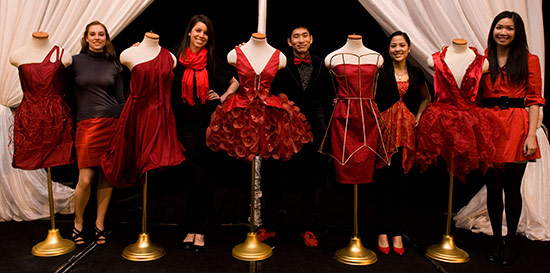
Heart Flood — Designer and model: Heidi Lo
|
Designer’s statement: When I received this assignment, the first thing I thought of is my friend Vivio. I knew she had a heart problem, but I didn’t know exactly what she was facing until one day she wore a bikini to her birthday pool party. I saw this long vertical scar on her chest along the center of her rib cage, and that was when I knew she had heart surgery. Vivio is a very bright girl who always stays positive about her situation. Therefore, I wanted my dress to be a gift for all the girls who suffered and recovered from a heart problem. The dress as whole represents the healthy heart, with red braids as veins carrying the blood around the neckline. The deep V cut on the front is for showing a scar from heart surgery. I want the wearer to be bright and feel encouraged when healed. I want her to feel proud because she made it through! I want to bring awareness to everyone to appreciate their precious hearts. |
Tins of Love — Designer: David Lee; Model: Vanessa Chin
|
Designer’s statement: Like Virgil said, “The greatest wealth is health.” Nothing matters more in our lifetimes than keeping sacred the value of our health and loved ones close to us. No one wants to see the people they care about in pain. It’s what makes us human and vulnerable. One of our biggest vulnerabilities is our susceptibility to disease. Growing up, I had a passion to help people. I too wanted to wear a stethoscope one day and be able to heal. I would realize years later that design was my strength. I didn’t let that stop my youthful ideals. When I first heard of this project in collaboration with the Women’s Cardiovascular Medicine Program, I took on the challenge. With my love for baking and design, I infused those two domains into a feminine silhouette to promote the message behind the program. Health is what drives us onward; and with improved women’s heart health, our mothers, daughters, sisters, spouses and friends can keep doing what they do best: living and loving without fear. |
Thread as a Metaphor — Designer: Ellen Griesemer; Model: Heidi Lo
|
Designer’s statement: When this project was introduced, I knew it was something I wanted to participate in. Initially however, I felt I didn't have enough of a personal connection to the topic. While still deciding on the design, I spoke with my aunt, whose response to my dilemma was one of surprise. She proceeded to give me a much more detailed family medical history than I'd ever heard before, including information about women's heart health within my own family. I designed this dress with that in mind. Thread and wire are metaphors for these familial connections as well as for surgery and repair. While I know now that I actually have many connections to the issue of heart health, never having had this conversation concerning my extended family meant I had been missing pertinent information. An unexpected inspiration, this project encouraged me to get informed and share my realization through design. |
Sanctuary — Designer: Mary Guillen; Model: Swasti Sarna
|
Designer’s statement: My dress symbolizes a sanctuary for women’s heart health. The interior red dress represents the heart at its normal state, vulnerable to heart conditions such as hypertension, coronary heart disease and cardiomyopathy. The metal enclosure signifies the ways women can protect themselves from heart disease and maintain a healthy heart by checking cholesterol, blood pressure and blood sugar levels; having a low-sodium diet; and exercising daily. The combination of the two elements creates a safe haven for the heart from illness. My personal experience with heart health has been witnessing my mother's struggle with high blood pressure over the last year. It started with mild headaches that grew to be unbearable. When it became troubling, she went to the doctor and discovered she had high blood pressure, which was not a surprise because my grandmother suffers from high blood pressure as well. Even while on medication, her blood pressure level will not allow her to go about her daily routine. She takes care of her heart by checking her blood pressure levels, reducing sodium in her diet and exercising when she can. Her enduring strength inspired the metal element of my dress. While my mother is strong spirited, she is still delicate just like the nature of our hearts. With a predisposition for high blood pressure, I know that I must take preventive actions against heart disease. Through this garment, I hope to inspire and inform women to take care of their hearts, because the heart is the core of our being. |
The Fragile Heart — Designer: Lucia Carrousel; Model: Heidi Lo
|
Designer’s statement: For my dress design, I was inspired by the gills on the underside of a mushroom cap. The elegant lines hidden underneath became the style lines in my dress. Just as a mushroom needs oxygen to survive, so does the human heart. The gills running from the top to the bottom of the dress represent the fragility of a woman’s heart. Our hearts are hidden underneath skin in our chests, yet are pumping nonstop to keep our bodies working correctly. The heart can be easily ignored because it is not on the outside to constantly remind us of how important it is. It is essential to raise awareness to protect and appreciate this vital organ because of its susceptibility to disease. I’m pleased to use my red dress as visual medium to deliver this message and to inspire women to keep their hearts healthy. |

Designer: Bruce Cheng
|
Designer’s statement: The heart and the color red are the themes of this red dress. To me, these are the symbols of power and passion. I designed a red dress for an urban woman and to show her power, health and energy. The heart is the focal point of the dress, and the flower-shaped fabrics illustrate the beauty and health of women. |
Designer: Candy Yang
|
Designer’s statement: My inspiration is a female gladiator fighting heart disease. I incorporated both medical and fashion aspects by using cheese cloth fabric/gauze for the top bodice and satin for the bottom. Although the red dress is a campaign for heart disease, I sought to incorporate my own style. As a result, I designed a one-shoulder dress. The dress has a slit in the middle because I wanted it to be different from others. In addition, I added a train to make the dress look elegant and powerful. |
Designer: Fiona Kim
|
Designer’s statement: The inspiration for my dress is an anatomical heart. I chose to do this in remembrance of a band instructor from my high school marching band who passed away abruptly from heart failure. |
Designer: Raena Rice
|
Designer’s statement: Heart disease is the number-one cause of death among women and, of these deaths, African-American women fall victim at higher rates than other races. Through creativity, young women of color can be made aware of this disease and start at a young age to take care of themselves and stay free of heart disease. I want to build awareness among young, African-American women in my own little creative way. |
Designer: Victoria Tu
|
Designer’s statement: I was inspired by red roses, which branched out to an analogy I made about the heart. The heart is like a rose. It is strong, like the thrones on the stem. But can be weak like the petals, if not taken cared of. So when a woman wears this dress, I want here to feel as lovely and strong as a rose. But I do not want her to feel weak -- so take care of the heart, and love life. |
Designer: Miquette Elliott
|
Designer’s statement: This dress design comes from my research on Carnaby Street Mod fashion circa 1960-1965 and poppies. I combined this research with a narrative expressing strength and fragility. The dress is a testament to the seemingly fragile elegance that is one of a woman’s many great strengths. The outer dress is made of silk organza, which is sheer but one of nature’s strongest fabrics, with wool poppies felted to it. |
Designer: Yer Lor
|
Designer’s statement: My design was inspired by stories of women who have heart disease despite practicing healthy habits. The arms are emphasized because they are symbols of strength. Even though the arms are strong, they are still not fully protected by the fabrics. The opening at the top of the sleeves and sheer fabric for the lower sleeves represent those vulnerabilities. I hope this design will remind everyone to not take their health for granted. |
Designer: Song Vu
|
Designer’s statement: Encircling the natural curves of a woman, this piece allowed me to trace the genuine beauty of women and recognize their inner strength, which is made possible by the beating of their hearts. To convey the importance of keeping the heart healthy and protected, I used the texture of lace as a symbolic reference to the veins that provide essential blood needed for every beat in life. The buttons are symbols of the risks we take when not considering our heart health, as they may become undone at any time. Along with embracing the natural femininity of women, my inspiration came from a desire to explore new materials. |
Designer: Frankees Samad
|
Designer’s statement: This dress is inspired by a family member who has a type of heart disease called dilated cardiomyopathy. This is a condition where the heart is enlarged and not pumping strongly. Because she has cardiomyopathy, she has fatigue, shortness of breath and poor exercise tolerance. Because her heart is enlarged, she can have abnormal heart rhythms. A cardiac defibrillator inside her chest prevents sudden cardiac death. An implantable cardioverter defibrillator monitors her heart rhythm and provides an electric shock to her heart if her heartbeat becomes dangerously abnormal. These are the reasons why I chose the QRS complex, which displays the heartbeat on an EKG monitor — a symbol of heart rhythm — in the design of this red dress. The ribbon pattern across the chest between the solid red satin below and the mesh chiffon above utilizes the heart rhythm pattern shown on the EKG monitor. |


